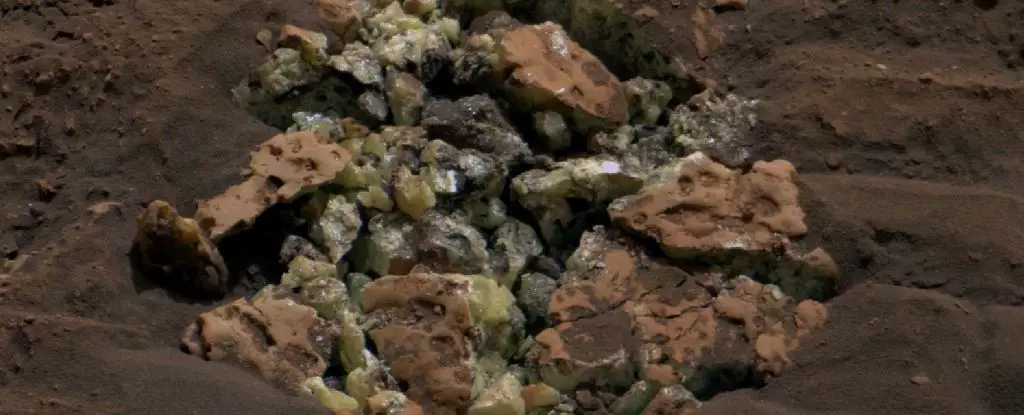In a stroke of luck that could rival any Martian adventure story, NASA’s Curiosity rover unearthed a remarkable surprise on the red planet: a rock that, upon being rolled over, revealed gleaming yellow crystals of elemental sulfur, or brimstone. Weighing in at 899 kilograms (approximately 1,982 pounds), Curiosity had traversed the Martian surface for years, but it was this seemingly mundane rock that offered a treasure trove of scientific insights after being cracked open in May. The discovery occurred within the Gediz Vallis Channel, a region that has been a focal point for research due to its geological history and potential implications for past water activity on Mars.
What sets this find apart is the fact that while sulfates—salts formed from sulfur interacting with other minerals—are common on Mars, this is the first instance where pure elemental sulfur has been identified in a natural state on the planet. The implications of this discovery are enormous, left tantalizing questions echoing through the scientific community. “Finding a field of stones made of pure sulfur is like finding an oasis in the desert,” remarked Curiosity project scientist Ashwin Vasavada from NASA’s Jet Propulsion Laboratory. His statement encapsulates the enthusiasm among researchers who thrive on the unpredictability and excitement that comes with exploring distant planets.
Sulfur is a crucial element for sustaining life on Earth. It is a key component in amino acids that form essential proteins for living organisms. While traces of sulfates have long been known to exist on Mars, indicating prior water activities, the presence of elemental sulfur introduces an entirely new narrative. This discovery hints that sulfur may not just be a trace element but potentially more abundant in certain regions than previously anticipated. The significance of sulfur emphasizes not just its role as a building block for life, but also its potential to inform us about past environmental conditions on Mars.
According to scientists, the conditions necessary for forming pure sulfur are rare and not known to have been present in the region surrounding the Gediz Vallis Channel. This contradiction raises further inquiries into the geological processes that shaped the Martian surface, leaving researchers questioning what other surprises lie hidden beneath the planet’s surface. The unexpected juxtaposition of pure sulfur alongside sulfates suggests a complexity in Martian environmental history that is yet to be fully unraveled. How did elemental sulfur form in a world characterized predominantly by its compound forms? The answers may lie in the intricate processes of Mars’s geological past that remain to be seen.
Analyzing the intersection of chemistry and planetary geology can offer invaluable insights. While elemental sulfur on Mars does not directly indicate current life, it opens windows into understanding the necessary conditions that could have once supported life. By examining the elemental makeup and configurations of rocks like the one Curiosity cracked open, scientists can reconstruct Mars’s past. Learning how sulfur occurred in its elemental form could provide clues to the planet’s historical atmosphere, hydrology, and overall evolution.
Curiosity, equipped with its suite of scientific instruments, has been diligently analyzing these sulfurous rocks. If not for the rover’s fortuitous path leading to the discovery, it might have taken an extended time before this unique feature was identified. The next steps involve deeper explorations and potentially intricate modeling of the geological evolution specific to the region. Each new discovery enriches our understanding of Mars, offering hope that it may one day help elucidate the age-old question of life beyond Earth.
While Curiosity continues to navigate the ancient riverbeds of the Gediz Vallis Channel, the road ahead is paved with exciting possibilities. The rover’s future missions include analyzing samples from a variety of rocks, delving deeper into the geological history of the Martian terrain. Each piece examined expands our understanding of Mars’s past, chronicling the dynamic history of a world once believed to have harbored life.
Every twist and turn in Curiosity’s journey is a testament to human ingenuity, ever striving to decode the mysteries of our nearest planetary neighbor. As we uncover Mars’s secrets, the excitement of discoveries like pure sulfur continues to stoke the fires of curiosity, illustrating the enchanting tapestry of our solar system, woven with stories waiting to be told. The greater mission remains: striving to uncover whether life, in any form, ever existed beyond Earth, drawn ever onward by the tantalizing allure of the unknown.


Leave a Reply